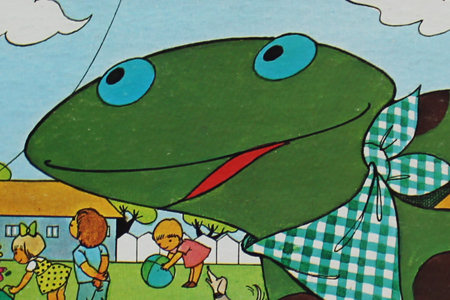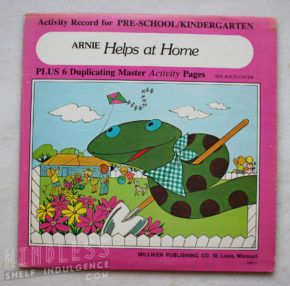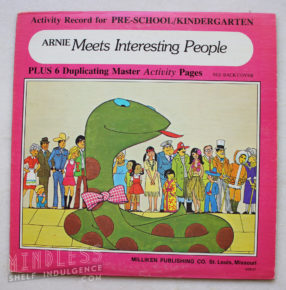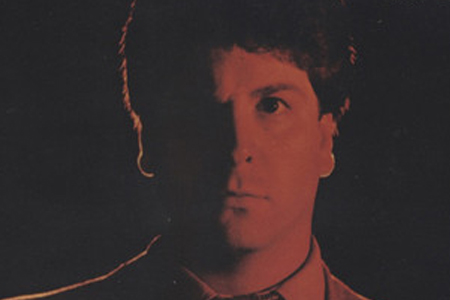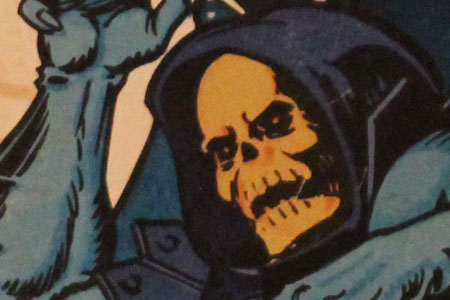
From the beginning of time, mankind has always tried to find ways to make kids less stupid, because when you really break it down, most kids are just a spindly sack of goopy organs on an accidental suicide quest. Fueled almost entirely by an improper balance between curiosity and caution, kids are a lot of hard work, so once they’re of an age where they won’t automatically self-destruct without constant monitoring, we send them to school, where ideally, those more well-equipped than ourselves to make our kids less stupid will do just that.
It’s nearly impossible to imagine another animal that gets angry at the prospect of cleaning itself properly, but that’s kids for you. So what do you do as a parent or teacher if those hygiene lessons are ignored by your little grease goblin? You call in Arnie the Snake. Sure, Arnie may not have had the impact of McGruff the Crime Dog or that green poison face Mr. Yuk in terms of educational mascot longevity, but for a certain section of kids in the late 70s and early 80s, Arnie was probably as good a teacher as any.
Arnie was the relatively nondescript star of a series of 10 educational LPs published in 1975 by Milliken Publishing of St. Louis, Missouri. Enormous and green, with brown spots and a bowtie, Arnie presented kids with a series of themed lessons which were accompanied by mimeographed worksheets. While this particular method of audiovisual teaching would be overtaken by audio cassettes and filmstrips in the mid-’80s, and then completely obliterated by VHS and Laserdiscs by the early ’90s, the educational LP was a classroom presence, just like anything else in the AV closet. So, what’s special about Arnie, the snake that time seems to have forgotten?
There’s not a whole lot of information about Arnie available; nobody seems to have found Arnie so memorable that they’ve posted him as some kind of lost media icon, and that might be because Arnie didn’t really have a wide reach. I found two of his LPs in the Connecticut area, after they were discarded from a school or library’s ‘Early Childhood Center’. But Arnie’s real significance was his ties to a semi-local St. Louis celebrity : DJ and radio personality Jack Carney.
Carney was a hugely popular radio DJ whose career took him on a nationwide tour that brought him back to St. Louis at both the beginning and end of his career, where his humor and style earned him a huge following of listeners, mainly teenagers, who would (according to legend) actively participate in mass stunts that he’d arrange on the air. In 1970, a short radio show hosted by Jack Carney was released on an LP as Cruisin’ 1958 – a combination of songs, radio ads, and Jack’s hosting spots. Aside from that well-preserved recording, when it came time to do a tribute show to Carney, it was apparently difficult for radio station KMOX to find many recordings of Carney, due to the mostly ephemeral form of radio broadcasting.
Jack Carney died suddenly in 1984 and was inducted into the Radio Hall of fame in 2001. But in none of his obituaries, discographies, or anything else about his contributions to culture, does it ever mention that he voiced Arnie the Snake for ten educational LPs.
Arnie doesn’t have the same edgy sense of humor as Jack Carney, since these records were designed for a preschool and Kindergarten audience. Arnie also seems a bit pushy and commanding at times compared to other softer kids’ educational characters, like Barney or Big Bird, telling kids to pick up their toys, and then to pick up their toys a little better because they messed up the first time. Occasionally, Arnie seems to forget that he’s a snake and starts talking about his arms and legs; there’s really no reason whatsoever that Arnie should even be a snake. He doesn’t stretch out his sssss sounds, and he doesn’t talk about eating mice or injecting venom into his prey. There’s absolutely nothing in this narrative that necessitates that Arnie be an animal with limited cuddle appeal at all; Arnie may have indeed gained more popularity if he was less reptilian. But there’s also a charm to Arnie; he doesn’t talk down to kids, and something about that feels nice. The lessons are simple, stuff about washing your hands and putting on your shoes, but he’s also no-nonsense.
It’s a neat, forgotten artifact from a really rich radio career. I reached out to Jack Carney’s son, a successful radio DJ himself, but he was not aware of these recordings, shrouding them in even more mystery. Milliken Publishing, now part of Lorenz Educational Publishing, didn’t respond to requests for information.
The LPs themselves are pretty interesting as well. Each individual track has its own runout groove that loops at the end, which means that one track doesn’t naturally run into the next like a regular LP, and the needle has to be manually shifted from one lesson to the next. It’s an uncommon trick for a record to pull; it’s obviously done so that a busy teacher can just let the track run out without having to run back to the record player, and it’s really neat.
As far as I can tell, Arnie just vanished after these ten lessons, presumably back to the land of giant snakes from whence he came, now replete with the knowledge of humanity that him and his snake brothers would use to puppet humanity from afar. But Arnie seems too kind for that; more likely, this avatar of basic human knowledge slumbers in a school basement somewhere, just waiting for the moment when the classroom DVD player breaks, and he can teach a new generation of kids about the importance of putting on your underwear before your pants. Bless you, Arnie.
 C. David is a writer and artist living in the Hudson Valley, NY. He loves pinball, Wazmo Nariz, Rem Lezar, MODOK, pogs, Ultra Monsters, 80s horror, and is secretly very enthusiastic about everything else not listed here.
C. David is a writer and artist living in the Hudson Valley, NY. He loves pinball, Wazmo Nariz, Rem Lezar, MODOK, pogs, Ultra Monsters, 80s horror, and is secretly very enthusiastic about everything else not listed here.
